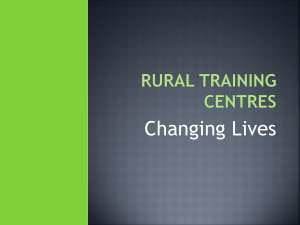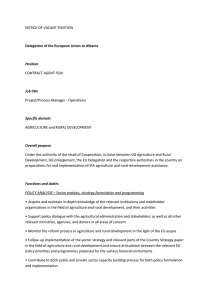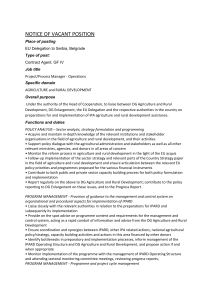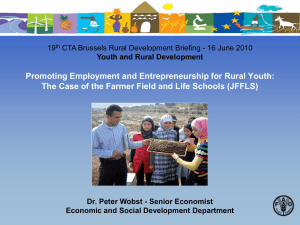Rural Economic Development - Garden City Community College
advertisement
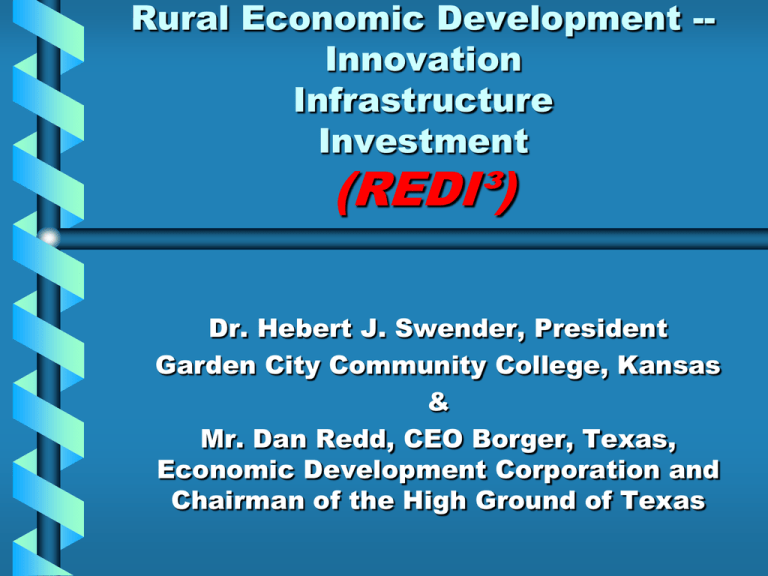
Rural Economic Development -Innovation Infrastructure Investment (REDI³) Dr. Hebert J. Swender, President Garden City Community College, Kansas & Mr. Dan Redd, CEO Borger, Texas, Economic Development Corporation and Chairman of the High Ground of Texas Leverage Existing Rural Partnerships • Local Economic Development Corporations • Regional Economic Development Consortiums • Existing Rural Community Colleges • Area Business and Industry 3 Key Factors in Real Estate and REDI³ Real Estate 1. Location 2. Location 3. Location REDI³ 1. Jobs 2. Jobs 3. Jobs 5 Critical M’s for Manufacturing – Are Also Rural Community College M’s! • Money (adequate) CC’s • Machines/Equipment (suitable) CC’s • Materials (available) CC’s • Methods (proven) CC’s • Manpower (qualified) CC’s Remember The Good Old Days • When American Companies did well-America did well! • When America did well--Americans did well! • What was good for Ford or General Motors was good for the country, and what was good for the country was good for Ford or General Motors! What Happened? • Most large corporations are now American in name only, but in fact are actually transnational. • Overseas the corporate slogan is “We are not American Corporations, rather International Corporations domiciled in America”. “Innovation” is necessary but is not sufficient or even enough… • PCs , laptops, and cell phones were all developed in the US, but none are currently manufactured here. • Manufacturing jobs (and profits) have been exported. • Consumer purchases contribute to the “Balance of Payments” –deficit. Manufacturing and Agriculture is critical because: • Manufacturing sectors have the highest economic multipliers. • Manufacturing provides maximum real “value added”. • National Defense considerations http://www.economyincrisis.org/cont ent/manufacturing-impotenceworries-national-intelligence-director One Example of Agricultural Export Concern –COTTON-• US produces 18 million bales of Cotton annually . • However, over 50% of US Cotton is exported to other countries. • U.S. Textile Mills consume only 4.5 million bales, but we use 20-24 million bales as a nation annually. • (we are too dependent on other nations for our finished cotton products). Rural Community Investment and Rural Community Colleges Provide literally more “bang for the buck” • Rural Communities have lower land costs. • Rural Communities have lower building, labor, and regulatory costs. • Rural Communities have underutilized assets. • Rural Community Colleges have capacity for increased enrollment in existing workforce education and training programs. • Rural Communities are generally MUCH more cost effective than in large urban areas. General Observations • The impact and aggregate per capita of a program or economic increase that creates 100 jobs in a rural community is much larger than large urban areas. REDI³--in the long term protects the self- interests of even the largest urban areas. REDI³ helps reduce the in migration from the rural areas and the need to continually expand urban infrastructure, e.g., roads, public education facilities, and emergency services—these infrastructures already exist in the rural areas. General Observations, …continued 2 • While 2% or less of the US population is now directly employed in farming, 100% of the American population continues to eat. General Observations, …continued 3 • Food commodity speculation and market manipulation through “futures” contracts and derivatives are impacting the increasing rural economic and social instability world wide— this is a national concern. U.S. Dept. of Labor’s Trade Adjustment Assistance Community College and Career Training Grant is “on-target” • TAACCCT Grants provide federal funds with measurable results utilizing existing community college infrastructure. • TAACCCT Grants encourage innovation in programs and delivery systems resulting in capacity building. • TAACCCT Grants remove barriers between community college service delivery areas and rewards consortium efforts. Rural Community Colleges are Already Providing Education for Agriculture Science Programs—Below is Garden City Community College, Kansas Community Colleges Prepare Nearly 8 in 10 First Responders Specialized Training--Ammonia Refrigeration: Garden City Community College, Kansas The Industrial Ammonia Refrigeration Program was established in 1996 as the first hands-on, live industrial ammonia refrigeration-training program in the U.S. It offers five-day seminars year-round, certifying refrigeration operators and Technicians from throughout the nation at three levels with training equipment provided by industry partners and grant funding. This program operates in partnership with the major trade associations of the U.S. ammonia refrigeration industry. Conclusions • If a solution is to be found, which is by no means certain, it must incorporate “data” • Tacit or subliminal assumptions are the most dangerous. • The academic discipline required is Econometrics. • Rural communities and their two-year colleges are ready, willing, and most certainly able to deliver economic, educational and workforce training, resulting in nation-wide and even global prosperity—REDI³ Our FUTURE—Get REDI³ • It’s a good idea to take an interest in the future—that’s where you will spend the rest of your life! …..Dan Redd, 2011


